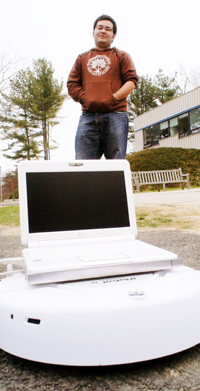Evolutionary Robotics

Isaac Asimov's stories made Bradford Barr 06F dream of designing robots one day. Hampshire College gave him the chance to actually build one.
 |
"When I was looking at colleges, I saw that Hampshire was one of the only schools with an artificial intelligence program available to undergraduates," says Barr.
A triple-major in math, computer science, and philosophy before transferring here, Barr found all of his prior studies tied in to his investigations at Hampshire on artificial intelligence (AI). With the support of computer science professors Lee Spector at Hampshire and Scott Kaplan at Amherst College, Barr branched into an area of AI called evolutionary robotics. That became the basis of his Div III, chaired by Spector.
"Older AI tried to take human intelligence and break it down to distinct modules, like language. They would give a robot a sentence, and try to get it to figure out what that sentence means," says Barr. "Evolutionary systems use a form of artificial evolution that doesn't have preconceived notions. I give the robot a goal, like move forward as far as possible without bumping into things, and allow it to adapt to the situation."
As random as it may sound, a lot of highly technical, highly specific design and programming (based around the Push GP language Spector wrote) still goes into giving the robot the ability to adapt. Barr's robot, about the size of a round bathroom scale, sports a laptop and a digital camera on top (which the robot uses to "see"), wheels on the bottom, and the potential ability to navigate its way through a cluttered world. Down the line, Barr could see more advanced versions being used in the service sector.
"Basically, everything was built from the ground up, to see if I could get the robot to learn to see," says Barr. "At the beginning, there were surprising results. It learned a fear response because it was given penalties for bumping into walls. So it would kind of just spin in circles."
Working past problems like that is what scientific inquiry is all about, and Barr is anticipating additional challenges this summer as a team leader for NASA's Robotics Academy's Intelligent Framework for Autonomous Exploration Systems at the Goddard Space Flight Center in Maryland. Tackling two robotics-based Ph.D.s is another goal, taking his knowledge of AI, as well as the engineering needed to apply it, to an even deeper level.

